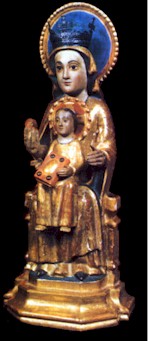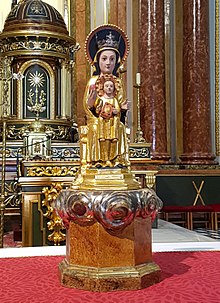Our Lady of Arrixaca
Our Lady of Arrixaca | |
|---|---|
 Our Lady of Arrixaca | |
| Venerated in | Roman Catholic Church |
| Major shrine | Church of San Andrés (Murcia) |
| Feast | Last Sunday of May |
Our Lady of Arrixaca (Spanish: Virgen de la Arrixaca) is a Marian devotion originating in Murcia, Spain, venerated in the capital since the 13th century.
The image of this Virgin is a polychrome wooden carving from the late Romanesque period, dating back to the 12th century. However, almost nothing remains of the original sculpture due to multiple restorations over time. Her feast day is celebrated on the last Sunday of May, commemorating the entry of Infante Alfonso (later Alfonso X of Castile), son of Ferdinand III of Castile, into the city of Murcia on May 1, 1243. This peaceful entry followed the Treaty of Alcaraz, an agreement made with the successors of Ibn Hud, the last true Arab emir of Murcia.
Legendary Origin
[edit]
The name Santa María de la Arrixaca comes from the Arrixaca quarter, where she was originally worshiped.
Another explanation is that the name may have Basque-Navarrese origins, similar to place names like Arriyaga, Arrillaga, Arrixaga, or Arrixaca. Linguistically, it could mean "place of stones.[1]
There is historical debate regarding whether the image was already in Murcia when Alfonso X arrived or if he personally brought it. One theory suggests that the image was located in a chapel in the Arrixaca suburb, where Italian Christian silk traders from Pisa and Genoa were allowed to worship. At the time, Murcia was one of the Mediterranean's main silk producers. An alternative theory suggests that Infante Alfonso brought the image with him and placed it in a Mozarabic hermitage in the Arrixaca quarter.
Regardless of its origin, Alfonso X dedicated a Cantiga to the Virgin, particularly Cantiga 169.[2]
Unofficial Patroness of the City of Murcia
[edit]The Arrixaca Virgin is venerated in the Royal Chapel of the Church of San Andrés in Murcia. Although she lost her title as patroness in 1746 in favor of Our Lady of Fuensanta, she remains one of the most important Marian devotions in the region. She has recently been proposed as the patroness of the Region of Murcia.
References
[edit]- ^ Deriving from "arri" (stone) and "-aga" (place of). The transformation of "x" or "y" in the name may be due to phonetic epenthesis.
- ^ Cantigas de Santa María: 169
